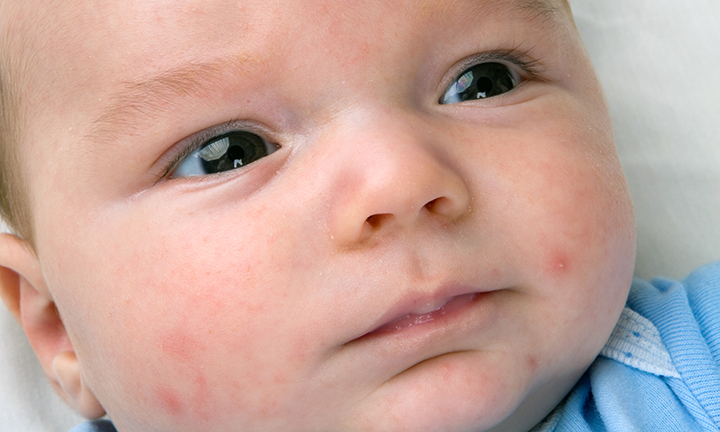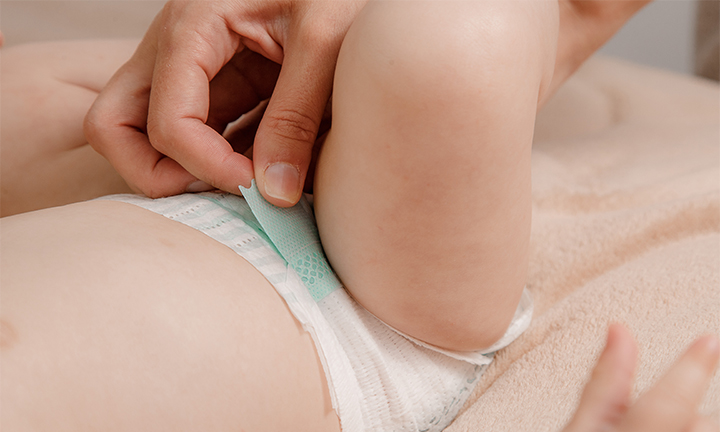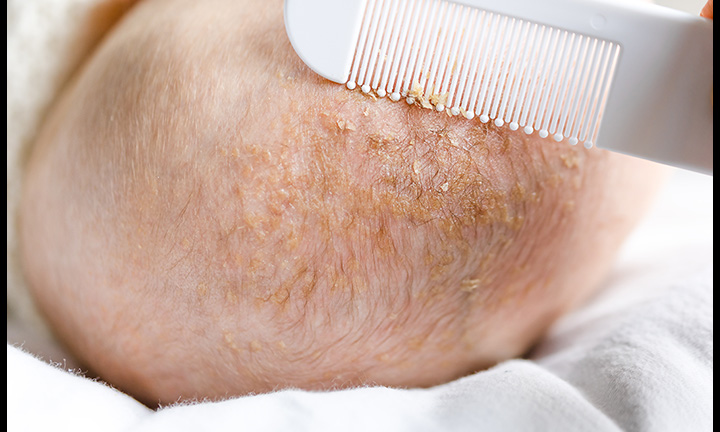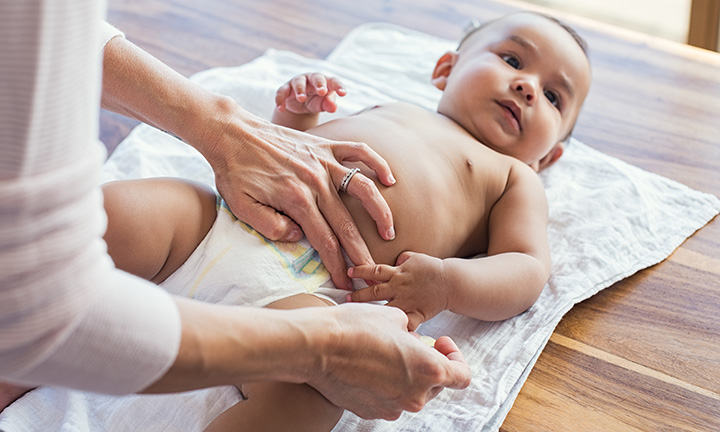
Common Types of Rashes in Newborns and Babies
From time to time, you may see a rash forming on your baby’s skin. It’s often not anything to worry about, but sometimes you might need to check in with your doctor or health visitor. Read on to learn about some of the most common rashes in newborns and babies and find out what you can do to treat them.
What Is Baby Rash?
A rash is a change to the usual skin often characterised by textural changes, for instance, the skin may feel bumpy or swollen. This may be accompanied by colour change, so the skin might look redder, darker or lighter than the original skin colour. A rash can be itchy, and sometimes may be accompanied by a fever. Rashes are often harmless, but keep in mind that a rash can also be a sign of an allergic reaction, or other condition that may need immediate medical attention. In this article, we’ll cover some of the most common types of rashes affecting babies. However, not all rashes are listed, so do contact your midwife, health visitor or a doctor if you have any questions or concerns about your baby's skin.
What Can Cause Baby Rashes?
The majority of rashes appearing in babies during the neonatal period are generally short-term and non-infective in origin. For instance, the common and benign rashes in newborns, toxic erythema and transient neonatal pustular melanosis. Some other cause of skin rashes in babies can include:
What Are the Most Common Rashes in Newborns and Babies?
In this section, we describe some of the more common rashes and skin conditions involving rashes in newborns and babies:
Nappy Rash
As the name suggests, nappy rashis a rash, sometimes with spots, pimples or blisters, that can develop on your baby’s nappy area. Nappy rash may appear red in colour on white skin or darker, lighter or violaceous in skin of colour.
Nappy rash can be triggered by:
Nappy rash typically clears up in three to four days if whatever’s causing it is alleviated. Tell your health visitor or doctor if the rash doesn’t go away or gets worse after a few days of taking the steps below. To help prevent or clear nappy rash:
Eczema
Also known as atopic dermatitis, eczema is a common skin condition causing rash in babies.Atopic eczema is a chronic inflammatory skin barrier disease manifested by a complex and poorly understood interaction between the infant’s genetics that formulate their skin barrier, their immune system in the skin barrier, and the environment around them. Changes in the skin barrier make them more prone to irritation from the external world leading to dry skin and inflammation. It’s a condition that can come and go depending on several factors. Parents of children with eczema sometimes have had Eczema themselves. Sometimes they have other atopic conditions such as Asthma or hay fever. Although some children with Eczema have food allergies, it’s thought that the food allergy does not cause the eczema and in fact, untreated Eczema may contribute to the development of food allergy.
You may notice patches of dry skin that may be red or darker, lighter or violaceous compared to the original skin colour, or itchy skin on your baby’s face or behind the ears. This type of rash can also appear in the creases of the neck, knees and elbows. Your baby will usually grow out of the eczema with time; but tell your doctor or health visitor if you think your child has it. To help soothe eczema or prevent it from reoccurring:
Rash on a Baby’s Face When Teething
A teething rash can form around the mouth, neck, upper chest and chin if your baby dribbles a lot. This often happens when your little one is teething, but excess dribbling for any reason can cause this kind of rash. This is why you might also hear it referred to as a dribble rash or drool rash.
Make sure to gently wipe your baby’s face often if they seem to be dribbling a lot, as this can help prevent this type of rash from forming. Ask your health visitor or doctor for advice if your baby has a teething or dribble rash that doesn’t go away.
Using a bib can help reduce the rash on the upper chest and neck – remember to change it regularly throughout the day. Remove saliva and food debris with a damp Muslin and apply a moisturiser to the cheeks once the skin is clean and dry.
Food Allergy Rash
When you’re starting your baby on solids, there’s a small chance that certain new foods could trigger an allergy.
Foods that sometimes cause an allergic reaction in small children include:
Just because these foods sometimes cause an allergic reaction in some children doesn’t mean you need to avoid giving these foods altogether, but experts do recommend introducing new foods one at a time. This way, if there’s a reaction you’ll know what caused it. If your baby does have an allergic reaction to a certain food, he or she may develop a rash. Other symptoms of a food allergy can include:
If you notice any of the above symptoms, stop giving your child the food that might have caused the allergic reaction, and tell your child’s doctor or your health visitor. Seek immediate medical attention if your child has difficulty breathing, seems confused or has trouble staying awake.
Erythema Toxicum
This type of rash is common and appears in the first few days after your baby is born. Your baby could have multiple raised red, yellow and white spots, especially on the face, back, belly, chest, thighs and upper arms.
The spots may disappear and then return again, but don’t worry: This kind of rash usually clears up by itself within a few weeks. It doesn’t need any treatment and although it can look alarming, it generally doesn’t distress babies.
Baby Acne
Maybe you weren’t expecting to deal with acne until much later, perhaps in your child’s teenage years, but newborn babies can break out in pimples too. Baby acne takes the form of red spots on your little one’s cheeks, nose and forehead.
The spots can show up in the first four weeks after birth, but usually clear up in a few weeks or months. Don’t use any anti-spot lotions, creams or medicines intended for adults or older children. Washing your baby’s face with water and applying a mild moisturiser might help though. If you have any concerns, see your GP. If the acne is very persistent or associated with your infant developing body hair see your GP urgently so an assessment of precocious puberty can be made.
Milia
These tiny white spots might show up on your newborn baby’s face. They often appear in the first few days after your baby is born and clear up in a few weeks without needing any treatment. This may be worse if you wrap your baby in too many layers or if heavy ointment-based balms are used.
Prickly Heat (Heat Rash)
Prickly heat, also known as heat rash , usually happens when excessive sweating causes a sweat gland to become blocked. After a few days, the trapped sweat causes a rash.
Heat rash can appear anywhere on your baby’s face or body and may also spread to other areas. Adults sometimes experience it too, but babies can get it more easily because they can’t yet control their temperature as effectively as adults and older children. The symptoms of prickly heat can include
The best way to prevent or treat heat rash is to keep your baby’s skin cool, for example by
To soothe the itchy or prickly rash
Cradle Cap
Cradle cap is one of the more common causes of rashes in babies. It can show up as greasy, yellow crusty patches on your baby’s scalp, most often in the first two months. The crusts can flake away, making the skin look red. In infants with skin of colour, the cradle cap may make the skin appear lighter than the original skin colour.
Cradle cap can also appear elsewhere, such as on your baby’s eyebrows and nose, or even around the nappy area. It’s thought to stem from a mite known as Malassezia interacting with the skin barrier. We all have this mite living on the skin, usually in harmony, so cradle cap is not considered to be contagious. It generally doesn’t itch or cause your baby any discomfort. Cradle cap usually clears up by itself within a few months, but there are a few things you can try to help that process along:
Scabies
Scabies is a rash caused by microscopic mites that burrow into the skin, laying their eggs.
It can appear as silvery lines with a red dot at the end, or as clusters of red dots. The rash can be very itchy, and appear almost anywhere on your baby’s body, although it often starts between the fingers. Scabies spreads easily from person to person (you can’t catch it from pets), but the rash can take eight weeks to appear after the mites lay their eggs. This means that if your baby has scabies the whole family will usually need to be treated because the mites may have been spreading before you realised there was a problem. Your pharmacist can recommend a cream or lotion that needs to be applied to the whole body, usually more than once. If your baby is less than 2 months old and you think a rash might be caused by scabies, take him or her to the doctor.
Hives
The rash known as hives is often itchy, but it can also feel like it’s burning or stinging. You’ll notice raised, red patches or spots, which can differ greatly in size and shape.
Hives is caused by an increase in the level of histamine and other chemicals produced by your baby’s body in response to certain triggers.
Things that can trigger hives include
• a virus
• an allergic reaction to an over-the-counter or prescription medication
• an allergic reaction to something your baby has touched, like soaps or plants
• an insect bite or bee sting.
Hives usually clears up in a day or two, but it can also be treated with an over-the-counter antihistamine. Ask your child’s doctor or pharmacist what could be suitable for your child. If your baby regularly has this kind of rash, see your doctor to help determine if your child is allergic to something. Seek immediate medical attention of your baby is having trouble swallowing or breathing, or if you notice sudden swelling in your child’s face, mouth or throat.
Impetigo
The rash associated with this contagious bacterial infection typically appears on the nose, mouth and hands, but it can also start around the belly area.
The first sign of impetigo in babies is the appearance of red sores or blisters that soon burst, leaving crusty golden-brown patches behind. These sometimes look like corn flakes stuck to your baby’s skin. They may get bigger and spread to other parts of the body. They can also itch, and sometimes even be painful. If you think your baby might have impetigo, take him or her to the doctor, who will usually take a swab to test for the bacteria that causes the infection. Based on the results of this test, your doctor may prescribe an antibiotic cream or medicine. Impetigo in babies isn’t usually serious, but it is infectious until the patches dry out and crust over (if no treatment is needed), or until 48 hours after starting the treatment prescribed by your baby’s doctor. Until then, keep your baby away from other children and avoid touching the rash, to help prevent the spread of the infection.
Ringworm
Don’t be alarmed: Despite its name, this common childhood rash has nothing to do with worms. In fact, it’s caused by a fungus that shows up as an itchy red (or darker or lighter than the original skin colour), or silver rash in ring or oval formations on your baby’s scalp or elsewhere on his or her body.
Your child’s doctor or local pharmacist can recommend a cream or lotion for treating the ringworm. If it appears on the scalp, medicine may also be needed – in this case it’s important to see a doctor. The infection can be spread from person to person or even from animals to people. Ensure your baby’s combs, brushes, hair clips or hats are not shared with others in the household if your child has ringworm. If you have a pet and you suspect that’s where the ringworm infection started a trip to the vet is needed to ensure your cat or dog is treated as well.
Roseola
Roseola is a contagious viral infection that’s very common in babies and toddlers.
Symptoms of roseola include a rash consisting of spots, patches or bumps that may be pinkish-red in colour, or darker or lighter than the original skin colour that start on your baby’s chest, belly and back. Later, this rash can spread to the face, neck and arms. In the three to five days before the rash appears, your baby or toddler will often have other symptoms, including
Your child with roseola can usually be looked after at home. Let your child rest, and make sure he or she gets plenty of fluid to stay hydrated. Ask your doctor or health visitor about medicine to help with any discomfort caused by the fever. The roseola rash may look dramatic, but it isn’t usually itchy or uncomfortable. And the good news is that by the time it appears, your little one is probably on the mend: The rash usually fades away in about two days, and it’s rare to get roseola more than once.
Slapped Cheek Syndrome
Slapped cheek syndrome, also known as fifth disease, is a common condition in children that sometimes starts with a high temperature (over 38 degrees Celsius), runny nose, sore throat and/or a headache and then a bright red rash on both cheeks – hence the name ‘slapped cheek syndrome’.
The bright red rash on your baby’s face could be followed by a lighter coloured rash of raised blotches – which may also itch – on the chest, arms and legs. This kind of rash usually clears up on its own in about three weeks without any treatment, although you can help ease your baby’s symptoms by
Common Rashes on a Baby’s Face
If you’re unsure about the type of rash that your baby has on their face, there are some common rashes that you can look out for:
If you notice a rash on your baby’s face, neck or anywhere else on their body, you can find more information about the various types of rashes in the section above and consult with your baby’s doctor, health visitor or pharmacist.
Common Rashes on a Baby’s Belly
Some common rashes that your baby might have on their stomach include:
If you spot a rash on your baby’s belly or anywhere else on their body, you can find more information about each of these rashes in the section above, detailing the common rashes in babies. It’s also recommended to contact your baby’s doctor, health visitor or pharmacist for a diagnosis.
When to See the Doctor
There are lots of different kinds of infant rashes, with many causes, and sometimes it can be hard for you to tell exactly which kind of rash your little one has. To be on the safe side or if you’re at all concerned, take your little one in for a checkup. Often the rash won’t be anything serious, however, if your baby or older child has a rash with a fever and seems unwell, it’s best to make an appointment to see the doctor so a professional diagnosis can be made. Call 999 or take your baby to A&E straight away if your little one has a rash and shows any of these other symptoms, which could be signs of meningitis, a rare but serious condition that needs urgent treatment:
FREQUENTLY ASKED QUESTIONS
Some common rashes found on babies include:
- Nappy Rash
- Eczema
- Teething
- Food Allergy Rash
- Baby Acne
- Milia
- Prickly Heat
- Cradle Cap
- Scabies
- Hives
- Roseola
- Slapped Cheek Syndrome.
If you notice your baby has a rash anywhere on their body, it’s important to contact their doctor, health visitor or pharmacist for a proper diagnosis and treatment.
Rashes are common and often harmless in babies and young children. Still, seeing a rash on your baby’s skin can be worrisome, especially if it’s accompanied by other symptoms. Figuring out what may have caused the rash isn’t always so simple. That’s why it’s a good idea to check in with your health visitor or see your baby’s doctor, who can diagnose the rash and suggest the most effective treatment. Soon enough, the redness, itching or irritation will fade away and you’ll soon be showering that soft, smooth skin with adoring kisses again, or – if you’re both in a playful mood –making your little one giggle by blowing raspberries on his or her tummy!
How we wrote this article The information in this article is based on the expert advice found in trusted medical and government sources, such as the National Health Service (NHS). You can find a full list of sources used for this article below. The content on this page should not replace professional medical advice. Always consult medical professionals for full diagnosis and treatment.
- NHS: Rashes in babies and children
- NHS: Symptoms - Insect bites and stings
- NHS: Symptoms – Allergies
- NHS: Conditions – Staphylococcal infection
- NHS: Conditions – Ringworm
- NHS: Conditions – Slapped cheek syndrome
- NHS: Conditions – Nappy rash
- NHS: Teething tips
- NHS: Atopic eczema
- NHS: Eczema
- NHS: Eczema in children
- NHS: Teething and tooth care
- NHS: Food allergies in babies and young children
- NHS: Anaphylaxis
- NHS: Heat rash
- NHS: Cradle cap
- NHS: Scabies: important information
- NHS: Scabies
- NHS: Hives
- NHS: Impetigo
- NHS: Roseola
Read more about Newborn Baby
Related Articles
Join Pampers Club and get:














